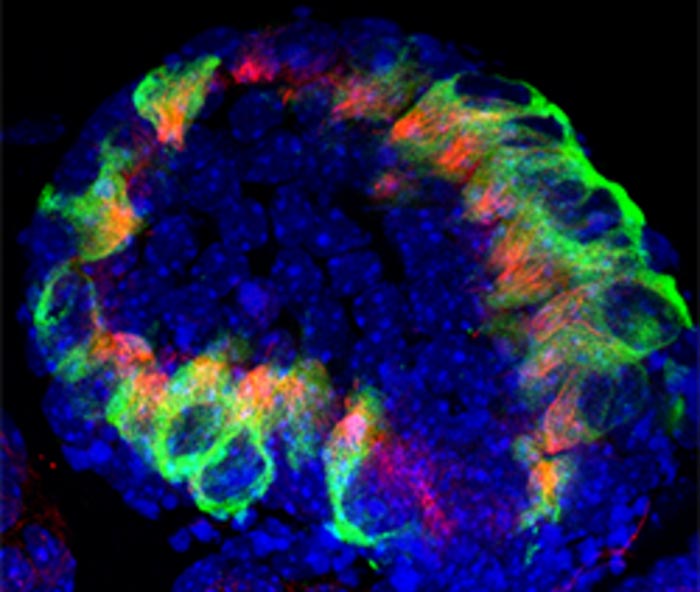Lab-grown cochlear organoids enable screening for hair cell-inducing drugs

Confocal microscopic image of a mouse cochlear organoid displaying hair cells (green) and their ciliary structures (red).
Credit: Qing Liu, Nanjing University, China
New research published in Stem Cell Reports found that organoid culture-based models for cochlear hair cell formation can be used to identify drugs that promote hair cell regeneration in a high throughput drug library screen.
Hair cells in the ear mediate the perception of sound. Consequently, when hair cells are destroyed or lost through exposure to loud sounds, certain chemicals, disease, or aging, partial or complete hearing loss is the consequence. According to WHO estimates, one in every 10 people worldwide will have disabling hearing loss by 2050.
Lost hair cells in mammals cannot be repaired or replaced, but intriguingly hair cells in other species like fish and birds have the potential to regenerate. The reasons for those differences are not fully understood, but it means that hair cell regeneration in humans may be possible under the right conditions.
To identify those conditions, Guoqiang Wan and colleagues from Nanjing University, China, generated cultures of inner ear-like structures, so-called cochlear organoids, from immature cochlear tissue of neonatal mice. Over time, these cochlear organoids multiplied and grew hair cells in the lab. The study, recently published in Stem Cell Reports, used these cochlear organoids to screen a collection of over one thousand FDA-approved drugs for substances stimulating hair cell formation. One of the most potent substances, an anti-cancer drug called Regorafenib, promoted hair cell formation in the lab-grown cochlear organoids. Notably, this compound also promoted hair cell formation in mouse cochlear tissues. Remarkably, hair cells were even regenerated in mouse cochlear tissues after having been destroyed by chemical exposure.
This work sets the stage for high throughput screening approaches to identity stimulators of hair cell regeneration in mammals as a potential treatment for hearing loss. Before this can be applied in patients, additional research is needed to address safety and to determine if the identified drugs can induce hair cells in the human cochleas.
Journal: Stem Cell Reports
Subject of Research: Animals
Article Title: High throughput screening on cochlear organoids identifies VEGFR-MEK-TGFB1 signaling promoting hair cell reprogramming
Article Publication Date: 14-Sep-2021
Media Contact
Kym Kilbourne
International Society for Stem Cell Research
kkilbourne@isscr.org
Office: 443-995-2102
All latest news from the category: Life Sciences and Chemistry
Articles and reports from the Life Sciences and chemistry area deal with applied and basic research into modern biology, chemistry and human medicine.
Valuable information can be found on a range of life sciences fields including bacteriology, biochemistry, bionics, bioinformatics, biophysics, biotechnology, genetics, geobotany, human biology, marine biology, microbiology, molecular biology, cellular biology, zoology, bioinorganic chemistry, microchemistry and environmental chemistry.
Newest articles

Combatting disruptive ‘noise’ in quantum communication
In a significant milestone for quantum communication technology, an experiment has demonstrated how networks can be leveraged to combat disruptive ‘noise’ in quantum communications. The international effort led by researchers…

Stretchable quantum dot display
Intrinsically stretchable quantum dot-based light-emitting diodes achieved record-breaking performance. A team of South Korean scientists led by Professor KIM Dae-Hyeong of the Center for Nanoparticle Research within the Institute for…

Internet can achieve quantum speed with light saved as sound
Researchers at the University of Copenhagen’s Niels Bohr Institute have developed a new way to create quantum memory: A small drum can store data sent with light in its sonic…





















